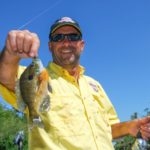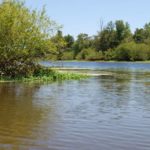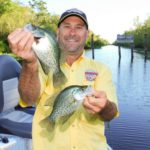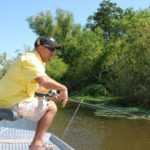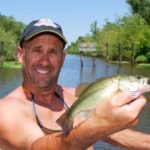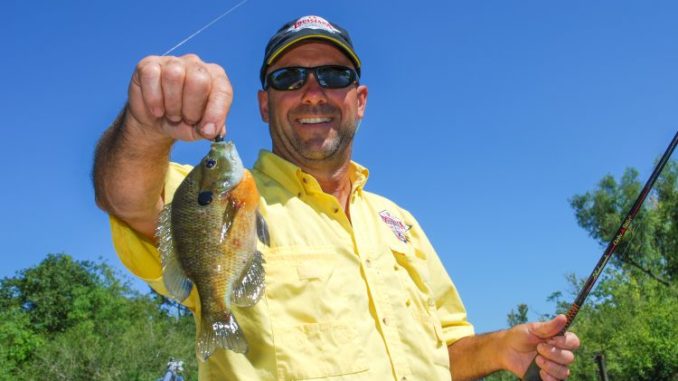
When the water drops out of the Atchafalaya Basin, this angler knows there’s one place in the sprawling swamp that is almost guaranteed to provide plenty of bream, sac-a-lait, catfish and bass.
When the winter-spring floodwaters fall out of the Atchafalaya Basin, everything that swims bites.
Unless a fisherman is a single-species snob, a day’s catch can include, largemouth and spotted bass, white bass, yellow bass, two species of crappie, three or four species of bream, blue catfish, channel catfish and the odd flathead catfish.
Something of everything — a real fruit salad.
John Langlois knows that and hits the Basin hard when the time is right.
I first met the self-employed sheetrock finisher when he had his 21-foot Cape Horn snapper boat, Snapper Time, parked at the CCA state convention to promote Louisiana Fish Fry Products (the boat was completely wrapped), where his wife Kristi runs the shipping desk.
I cadged a trip with the master trophy red snapper fisherman. He and his son-in-law put some true giants in the boat.
But in the middle of catching those huge sows, he told me his first love was freshwater fishing in the Atchafalaya Basin, a river swamp I truly love.
Langlois’ father Joseph was born in New Roads and grew up fishing False River. He brought young John back to the big oxbow lake near his home town to fish its famous bream beds on the flats at each end of the lake.
When the dense grass beds died out in the 1980s, the pair started fishing together in the Atchafalaya Basin. A friend’s uncle tipped them off to catching fish in the Williams Canal.
“This canal has produced so many fish for me,” Langlois grinned. “Ninety percent of the time, when the water is down, I can count on catching a big variety of fish.
“Dad and I fished here every weekend, and when I was off work, two or three days during the week. Every time we would come, we would fill an ice chest until you had trouble closing the lid.”
It’s still a special place for him.
“I still fish it twice a week in July and August,” Langlois said.
We launched at the Bayou Sorrell Public Launch and ran south in the Intracoastal Waterway past the Pigeon launch (It’s faster by water than by land).
Near that second boat ramp, Langlois hung a right, heading west into Big Bayou Pigeon and then took another right into Cross Bayou.
Cross Bayou is eye candy — what tourists would envision as a true swamp. Craggy cypress trees festooned with Spanish moss line its banks. The bird life is phenomenal — gobs of ibis, blue and slate gray herons, snow white egrets and the occasional hot-pink roseate spoonbill (affectionately called by some “Cajun plumingos”).
“Cross Bayou is a well-known fishing destination in its own right,” Langlois barked over his outboard motor. “When the river levels hit dead low and it gets shallow elsewhere, the fish fall back into the bayou.”
A short run up Cross Bayou took Langlois to its intersection with the Williams Canal, the locus of Langlois’s attention this day.
Good fishing is found in the canal going either way from Cross Bayou. The best fishing, however, is where cuts, canals and drains intersect with Williams Canal, the angler said.
This day, Langlois turned to the east.
Williams Canal runs east and west, and extends all the way to the Intracoastal Waterway that runs along the east Atchafalaya guide levee.
But because of silting in a stretch of the canal, Langlois prefers to make the Big Bayou Pigeon-Cross Bayou circle to get to the canal.
At the first opening — an intersection between the canal and a north-south pipeline canal — he shut down and dropped his trolling motor. A slowly moving current coming down the pipeline was dumping water into Williams Canal.
Langlois shot a cast to where the different-colored waters were mixing.
The result was immediate — a chunky crappie.
From there, the action was blistering. Every cast, every cast, every cast was a crappie, bluegill or goggle-eye.
This was not finesse-fishing; it was fun-fishing.
The falling water had put the fish in an aggressive mode. No cover-casting was necessary: The fish were just lying in the open water of the intersection, grabbing goodies carried to them by the current coming down the pipeline canal.
Even Langlois was impressed.
It was so good it actually got boring for him.
“I know that we are catching fish,” Langlois said, “but I want to give a favorite spot a shot.”
He chugged to the east in the canal until he reached a cypress-fringed opening draining the big swamp to the right into the canal.
Langlois worked it hard, reciting times past when he filled the boat here. But it was a nonstarter today, and soon he went back to where he began.
The fish were still there, but they had clustered on one corner of the intersection near a protruding patch of water hyacinth.
The angler tried to give everything a chance to get caught.
He would cast a jig under a cork, work it halfway in, stop and let it sit there for passive biters while he picked up another rod that was Carolina-rigged with a watermelon-bluegill V & M Baby Brush Hog.
All the while, he had yet another rod baited with a small wad of worms that was cast into the middle of the canal on the bottom for catfish.
“Funny! Funny!” Langlois laughed. “I’m a multi-task fisherman.”
Watching him juggle three rods, working the Carolina-rigged rod by feel while keeping an eye on each of the other two rods was comical.
“I’ve got too much going on,” Langlois chuckled. “But I love it; I love it!”
All this from a guy who put his name in the record books chasing red sea monsters in blue water miles offshore.
But he wasn’t offshore; he seemed to be in heaven.
When the pace of the bite slowed a bit, he took his brightly colored cork off to fish tight-line.
“That’s what’s good about a snap-on cork,” Langlois muttered.
That turned the charm.
Bang — bang — bang.
Almost every cast was a crappie, with an occasional bluegill or goggle-eye thrown in for spice.
How many fish you ended up with was simply a function of how many casts you wanted to make.
Although it was still relatively early, the day quickly became hot, and Langlois shucked his shirt. The stocky 50-year-old didn’t have any fat on his big-boned body.
His heavily creased, masculine face, shaved head and closely cropped beard gave him the look of a boxer.
Half the fun of the day was watching the burly fighter giggling over catching little speckled fish.
